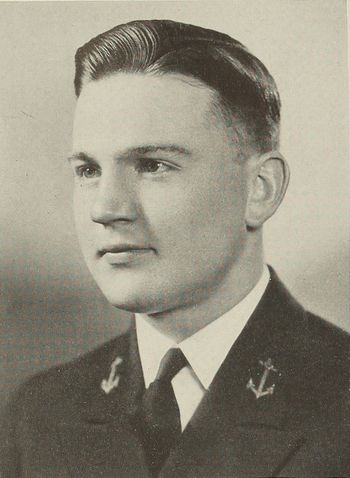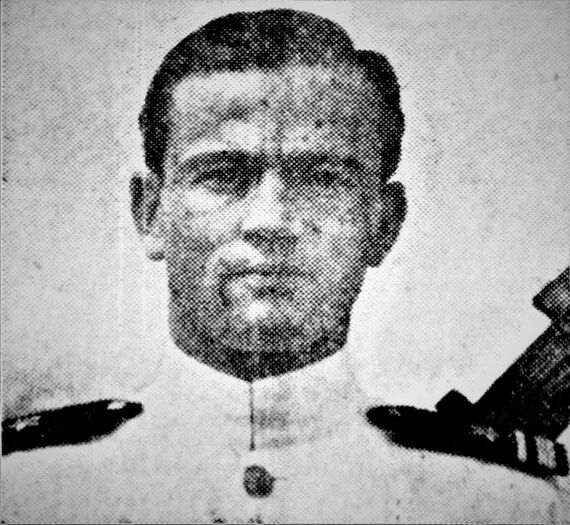SHIELDS GOODMAN, LT, USN
Shields Goodman '37
Lucky Bag
From the 1937 Lucky Bag:
SHIELDS GOODMAN
Little Rock, Arkansas
"Goodie" "Shields" "Sammie"
Shields hates to admit that he once hoped to enter West Point. Happily he outgrew that foolish idea and became a welcomed addition to our class. We soon came to marvel at his athletic and academic powers. Lack of weight and a back injury forced Goodie to give up football, but he still wielded a fast tennis racquet. Academics never worried him, as he could always crack an exam if necessary. Everyone who wanted information cornered Shields, for he had the latest scuttlebutt, knew the latest song hits, or could give the best advice on heart problems.
Tennis 4, 3, 2, 1. Pep Committee, Two Stripes.

SHIELDS GOODMAN
Little Rock, Arkansas
"Goodie" "Shields" "Sammie"
Shields hates to admit that he once hoped to enter West Point. Happily he outgrew that foolish idea and became a welcomed addition to our class. We soon came to marvel at his athletic and academic powers. Lack of weight and a back injury forced Goodie to give up football, but he still wielded a fast tennis racquet. Academics never worried him, as he could always crack an exam if necessary. Everyone who wanted information cornered Shields, for he had the latest scuttlebutt, knew the latest song hits, or could give the best advice on heart problems.
Tennis 4, 3, 2, 1. Pep Committee, Two Stripes.
Loss
Shields was taken as a prisoner of war following the fall of Corregidor and was killed on December 15, 1944 when American aircraft mistakenly attacked the POW ship (Oryoku Maru) he was aboard. According to his friend and co-prisoner LTjg Ken Wheeler, Shields had been in the after hold of the ship and was killed instantly.
Other Information
He was held at Davao Penal Colony #502 for some time.
The Courier Journal (Louisville) on March 3, 1944, via Kathy Franz:
Lt. Shields Goodman Runs Boat for Japs
Good news concerning the health and safety of Lt. Shields Goodman, a Jap prisoner since the fall of Corregidor, has been received by his mother, Mrs. P. H. Goodwyn. Not only was the news exciting but its source was also since it came from Com. Melvin McCoy, U.S.N.R., who was written up in Life’s magazine’s story of “Death Was Part of Our Life,” February 7, based on the escape of several men from a Jap prison camp.
After the fall of Corregidor the War Department notified Mrs. Goodwyn that her son was missing and for a year that was the only news she had of him. After that period of time she received four postcards stating that he was a prisoner, the last of which arrived before Christmas. When the escapees reached this country, not only Commander McCoy, but Maj. Michiel Dobervick communicated with Mrs. Goodwyn to say that Shields’ health and spirit were both good and that the Japs have given him a trusted job in charge of a boat which takes ten-day trips gathering coral rock that is used for fertilizer.
These officers said they had been with Shields at Camps 1 and 2, adding that conditions have been improved somewhat now that the Red Cross supplies are getting to the prisoners better. For instance, Lieutenant Goodman recently received fifteen cans of corned beef and vegetable stew, and in addition they get plenty of quinine.
Lieutenant Goodman was in the regular Navy two years before Pearl Harbor, stationed in Hongkong. His mother felt that his morale must be good, as his last communication was concerned with a request for a Chrysler convertible “if priorities permit.”
His mother was listed as next of kin. Shields has a memory marker in Arlington National Cemetery.
Photographs
Wartime Service
Shields is listed as having been an officer aboard USS Mindanao (PR 8). That river gunboat had departed China on December 2, 1941, and took some of the first Japanese prisoners of war on December 9, 1941 while enroute to Manila. The vessel was heavily engaged in the spirited but ultimately desperate actions against the Japanese in Manila Bay and surrounding. The officers and crew had been transferred to help defend Fort Hughes on April 10 after the ship had been stripped of useful equipment. She was ultimately sunk to prevent capture in early May 1942.
There is mention of Shields in a September 1943 newspaper: his "last letter was mailed from his ship in March 1942."
Shields is quoted in a letter home; the date is not given. From "The Jersey Brothers: A Missing Naval Officer in the Pacific and His Family's Quest to Bring Him Home":
We are presumably awaiting transportation to Japan . . . [If so] I shall leave this letter with one of the hospital patients because the prisoners here will undoubtedly be back in American hands before those sent north to Japan. I have great hopes that our forces will come in before the Nips can get us out. We hear that Americans have landed 350 miles to the south of us . . . Our planes have been overhead nearly every day since we arrived here. They have bombed the airfields and the port area and we hear that there are no Nip freighters or any other ships in the harbor . . . We feel that our insurance against being sent north becomes more concrete with each air raid . . . Happy day it's going to be when we are all reunited again. These last . . . years will fall away from us like leaves from a tree in fall, and it will seem . . . that we have never been apart.
He was mentioned a handful of other times in the book.
Prisoner of War Medal
From Hall of Valor:
Lieutenant Shields Goodman (NSN: 0-78606), United States Navy, was captured by the Japanese after the fall of Corregidor, Philippine Islands, on 6 May 1942, and was held as a Prisoner of War until his death while still in captivity.
General Orders: NARA Database: Records of World War II Prisoners of War, created, 1942 - 1947
Action Date: May 6, 1942 - Died in Captivity
Service: Navy
Rank: Lieutenant
Division: Prisoner of War (Philippine Islands)
The "Register of Commissioned and Warrant Officers of the United States Navy and Marine Corps" was published annually from 1815 through at least the 1970s; it provided rank, command or station, and occasionally billet until the beginning of World War II when command/station was no longer included. Scanned copies were reviewed and data entered from the mid-1840s through 1922, when more-frequent Navy Directories were available.
The Navy Directory was a publication that provided information on the command, billet, and rank of every active and retired naval officer. Single editions have been found online from January 1915 and March 1918, and then from three to six editions per year from 1923 through 1940; the final edition is from April 1941.
The entries in both series of documents are sometimes cryptic and confusing. They are often inconsistent, even within an edition, with the name of commands; this is especially true for aviation squadrons in the 1920s and early 1930s.
Alumni listed at the same command may or may not have had significant interactions; they could have shared a stateroom or workspace, stood many hours of watch together, or, especially at the larger commands, they might not have known each other at all. The information provides the opportunity to draw connections that are otherwise invisible, though, and gives a fuller view of the professional experiences of these alumni in Memorial Hall.
September 1937
January 1938
October 1939
April 1941

The "category" links below lead to lists of related Honorees; use them to explore further the service and sacrifice of alumni in Memorial Hall.
